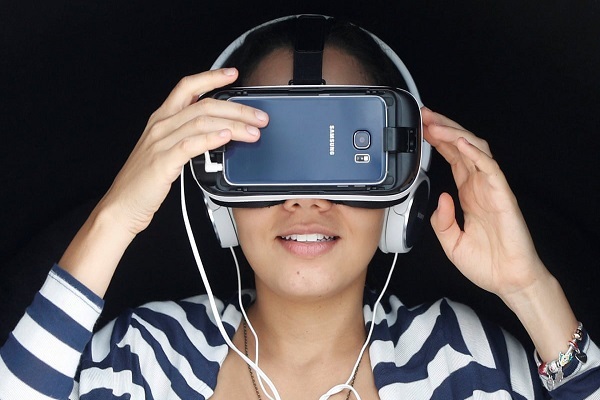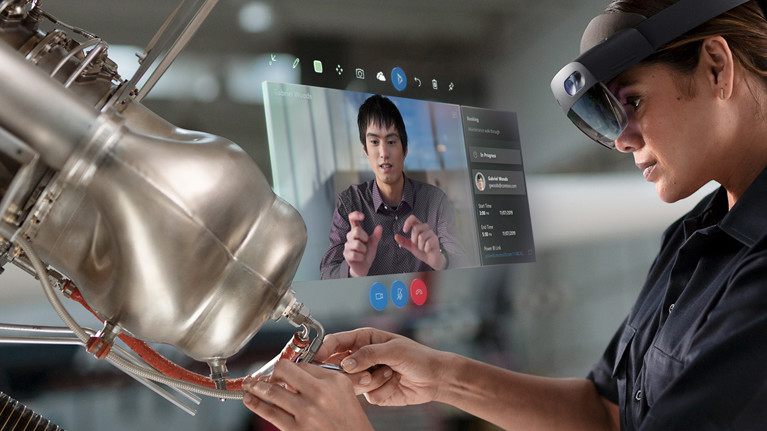Samsung ‘hides itself and waits for time’ in the augmented reality glasses race?
- Tram Ho
2022 will be a defining year for virtual reality (VR) and augmented reality (AR), the most prominent topics at the past CES. Sony, Microsoft and Qualcomm, among others, are all expected to move into the VR and AR wearables race this year or next.
Last time, Samsung was very quick to mark its presence with a line of smartphone-based wearables, Gear VR, launched in 2014. But since then, rival companies like Meta, Microsoft and Snap have made further strides.

Samsung is known for regularly experimenting with new technology, typically against key competitors like Apple. The company’s decision to jump into the Android smartphone market more than a decade ago has made the company the largest player in the mobile device market in the world. This makes Samsung’s relative silence in the smart glasses race confusing.
Opponents “raise their voices”
While it may be a long time before smart glasses become useful enough to occupy a place in people’s daily lives, the industry seems to be eager to get there. The year 2022 kicks off with a flurry of announcements at CES, when Microsoft and Qualcomm reach an agreement to produce custom processors for AR glasses, and the concept models from manufacturer TCL look like a higher version of the original. Google Glass. Sony also teased the second generation of PlayStation VR, although there are no details on pricing and release date yet.
2021 sees many important advancements for AR and VR, one of the biggest being Facebook’s change of name to Meta. The change reflects the company’s larger goals, expanding beyond social media and focusing on building the metaverse, the umbrella term for the digital community that encompasses both AR and VR.
Meta announced the smart glasses project Nazare last year and has already launched its first pair of connected glasses, RayBan Stories. While they don’t have AR features and are primarily designed for hands-free photography, these devices are still a step forward for future smart glasses.
Currently Meta is also the market leader in VR with the Oculus VR device. According to International Data Corporation, Facebook’s parent company accounts for nearly 75% of the AR and VR wearables market.
Snapchat’s parent company Snap, in 2021 also launches the first wireless AR glasses, capable of displaying 3D effects on real surroundings and tracking hand movements. While these devices are primarily intended for app developers, Snap has developed three generations of Snapchat Spectacles to date, a signal that the company is serious about its pursuit of technology. this technology.

Meanwhile, Microsoft, one of the first companies to jump into the AR and VR market with the HoloLens AR device since 2015. It also launched the second generation in 2019 and added 5G to the 2020 version. .
Apple, the world’s largest tech company by market capitalization, hasn’t released any VR or AR products yet, but rumors are growing that it will launch a device this year. The iPhone maker is expected to launch AR and VR-capable wearables for developers in 2022 (or in 2023), laying the groundwork for consumer-friendly commercialized smart glasses. use in the future.
CEO Tim Cook affirmed that AR when used with phones is a breakthrough, and this technology is very important for the future of the company. Apple has long provided tools for developers to build AR apps for iPhones with the ARKit platform, but recently it started to deepen its integration of Lidar sensors (which support 3D modeling) into some devices. certain iPhone and iPad Pro models.
Hide yourself to wait time?
As for Samsung, it hasn’t released a new version of its Gear VR device since 2017. It seems that the Korean company is focusing on another aspect of AR. For example, at CES 2022, Samsung launched the concept of integrating AR into the car’s front glass to display weather information, tire pressure, maps or other information. The company also teamed up with the social app Zepeto and 3D avatars to create a digital home of its products at CES. Those moves show that Samsung is not going beyond the current metaverse trend.
Earlier, at CES 2020, Samsung brought the concept of AR glasses combined with an exoskeleton to bring a virtual workout experience. Further in 2017, the company also introduced a glass concept called Monitorless at the Mobile World Congress (MWC).
Two leaked videos in 2021 show that the Korean technology company is working on AR glasses capable of displaying a giant screen in front of the user’s eyes or placing 3D objects in the surrounding real environment.
Samsung says its research teams are “continuing to develop core technologies for smart devices, including AR glasses, the next generation of wearables.”
“AR glasses are expected to become the next IT device because they have a greater immersive advantage in environments than on mobile phones. Users don’t have to hold or pull them out of their pockets to enjoy a private display of their own,” according to Samsung Research.
Korean corporations often refuse to sit out with new technologies. The company launched its first smartwatch (Galaxy Gear) back in 2013 when the whole industry was still shy. For comparison, until 2015, Apple launched the first generation of Apple Watch.
The story is similar for technologies like curved screens or folding phones. Since 2013, Samsung has launched Galaxy Round (curved screen phone) before bringing curved edges to recent Galaxy phone models.
The Galaxy Z Fold, which was one of the first foldable phones released in 2019, has now progressed to its third generation. Talking about the rapid adoption of folding phone technology, the rest of the smartphone industry has not been able to catch up with the Korean giant.
To become “mainstream” like smartphones or smart watches, smart glasses will have to solve a number of challenges such as improving battery life, compatibility with phones or ease of wearing with prescription glasses. .
It is clear that Samsung is weighing the risks of entering the market early and the trade-offs of waiting for a years-long process, or it can launch simpler products in the meantime like glasses. audio from Amazon and Bose.
It’s also important to note that Meta and Microsoft are inherently companies that have missed most of the smartphone boom, so they have a greater incentive to prevent the smart glasses market from becoming a race. bicoding between Apple and Samsung. However, Samsung is currently the world’s leading smartphone manufacturer (according to Counterpoint Research) and holds the second position in the wearable market, so the silence of the Korean technology company certainly creates a gap. or a big push for AR/VR technology.
According to Cnet
Source : Genk
